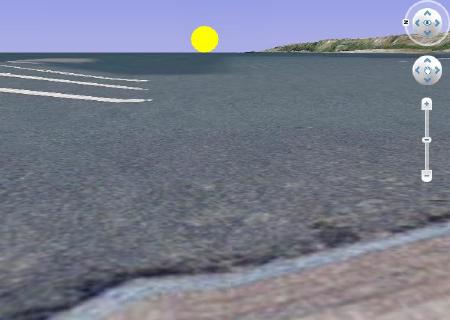We’ve had fun watching the comments posted on my recent entry, East Coast Sunsets over Water. Matthew kicked things off when he wondered whether the opposite condition might exist. Does a West Coast sunrise ever happen over water? Scott Schrantz who has followed the Twelve Mile Circle for awhile, later solved the mystery by providing definitive evidence.
The Obvious
I’ve been out of town all week. However, now that I’m back I’ve been able to review the candidates and offer an assessment. First, lets take care of the obvious. Hawaii. Yes, it’s in the middle of the Pacific Ocean. By definition it will have lots of places where the sun rises over water. Also Alaska:
Much of land along the western edge of the Gulf of Alaska provides unobstructed eastern views. Think the Kenai Peninsula, the Alaska Peninsula and down to the Aleutian Islands. Some of the crags on the peninsulas along Alaska’s western coast might qualify when free of ice. Ditto for various nobs and bumps along the northern slope.
Focusing on the Lower 48
Then things get difficult. There are two major geographic conditions within the western coastal states of the Lower 48 (Washington, Oregon and California) that inhibit this phenomenon:
- There aren’t many significant peninsulas or other protrusions jutting from the mainland. Also, there’s a distinct lack of barrier islands offshore.
- A series of tall mountains, the various Pacific Coastal Ranges, run all the way from Alaska to Mexico. Mountains do extend the horizon considerably. Unfortunately that means someone will have to be much further away over water to no longer see land.
Washington
Efforts focused on the the northwestern corner of Washington, the Olympic Peninsula. It’s the only sizable peninsula along the western coast. That seems like it might create the proper conditions. However the Cascades Range rarely dips below 5,000 feet. So that would definitely impact the horizon.
Referring to Wikipedia’s horizon chart, a viewer would have to be at least a hundred miles west of the Cascades to no longer see a continuous ridge across the horizon in clear weather. This completely eliminated anything along the western shore of Puget Sound.
Straight of Georgia
I thought, well perhaps the Strait of Georgia might hold some promise. There’s little of the United States with an eastern view along the strait, but Point Roberts, one of my favorite geo-oddities does have the proper positioning. No dice, though. It’s still too close to the Northern Cascades. I confirmed that with a photo I found on Flickr. It’s a gorgeous sunrise and substantially over water but we’re looking for perfection here, 100% over water. Sorry, Point Roberts, I have to throw you in the discard pile this time.
Port Angeles
The Strait of Juan de Fuca became another likely candidate. This separates the Olympic Peninsula from Canada’s Vancouver Island. It’s long and broad, and held the promise of uninterrupted horizons. However it runs southeast. An over water sunrise would likely depend upon the positioning of the surrounding landmass and the time of the year. Scott Schrantz posed and confirmed the theory by finding conclusive evidence of a sunrise over water at Port Angeles on Flickr.

Here I’ve attempted to recreate a similar scene from the Port Angeles city dock using Google Earth. This image faces directly towards the eastern horizon at eye-level with 3D turned on. I’ve added the sun just south of east to approximate the date of the Flickr photo, March 6. From this I can deduce that while the headland is visible to the right, the shoreline plain forming Dungeness Bay must be below the horizon. Otherwise the sun would rise over it.
We can speculate that sunrise over water would definitely occur between the vernal equinox (late March) and the autumnal equinox (late September) for sure, plus probably another month on either end. Theoretically the situation should only improve as one moves further along the top of Olympic Peninsula towards the Pacific Ocean since it takes a decidedly northwestern slant after Port Angeles.
California
I could find only one other spot along the coast where I positively identified a sunrise over water. That happens in the Channel Islands off of southern California. The mountains behind Los Angeles appeared in the preponderance of on-line photographs from Catalina Island and its primary town, Avalon. However I did find an example on Flickr. I think it’s probable that it occurs only during certain parts of the year. The angles need to line up just right, similar to what we discovered on the Olympic Peninsula.
Indeed west coast sunrises happen over water. However, they are extremely rare compared to their reverse counterparts on the east coast. This was a fun entry to compile and I particularly enjoyed the group effort. If anyone has other topics to explore, please feel free to post them and we’ll start the discussion again.

Leave a Reply